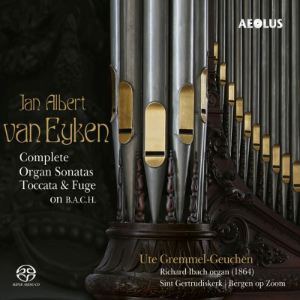
Jan Albert van Eyken (1823-1868)
Complete Organ Sonatas
Toccata and Fuga on the name of B.A.C.H. in B flat major, Op. 38 (1865)
Sonata No. 1 in C minor Op. 13 (1854)
Six Variations & Finale on ‘Wien Neêrlands bloed’ Op. 7
Sonata No. 2 in D minor Op. 15 (1854)
Chorale prelude ‘Nun ruhen alle Wälder’ in G major
Chorale prelude ‘Rust mijn ziel! Uw God is Koning’ in F major
Sonata No. 3 in A minor Op. 25 (1857)
Abendlied in D flat major Op. 85 (1849)
Ute Gremmel-Geuchen (organ)
rec. 2022, Sint-Gertrudiskerk, Bergen op Zoom, Netherlands
Aeolus AE11371 SACD [80]
If your’e not familiar with the name of Dutch composer Jan Albert van Eyken, then his better-known younger brother Gerrit Jan van Eyken might ring some bells. Jan forged a career as both an organist and composer. Born in Amersfoort in 1823, he began taking lessons from his father who was the town’s organist. He later progressed to the Leipzig Conservatory, where he came under the influence of Felix Mendelssohn. He later studied in Dresden before taking up a post as organist at the Remonstrantenkerk in Amsterdam in 1848. In 1854 he became organist at Elberfeld. Sadly, he died in 1868 at the young age of only 45, leaving six young children.
Perhaps his obscurity can be put down to the fact that his compositional output was meagre, to say the least. Apart from the contents of this release, we can add just a few short pieces, a handful of psalm arrangements, some chorale preludes and transcriptions. This disc includes all of his more substantial works. All, apart from the Organ Sonata No. 2, and the Toccata and Fuga on the name of B.A.C.H. are appearing on disc for the first time.
Organist Ute Gremmel-Geuchen has chosen to record this programme on a three-manual Richard Ibach organ built in 1864, housed in Sint-Gertrudiskerk in Bergen op Zoom. It underwent a restoration in 2011. Apparently it’s the largest surviving organ the company built. Van Eyken was very familiar with the Ibach instruments, which makes the pairing of the music with this organ particularly apposite. The organ’s specifications are included at the back of the booklet.
The Sonata No. 1 in C minor, Op. 13 appeared in print in 1854 and bears a dedication to van Eyken’s teacher Johann Schneider. It’s the only one of the three sonatas to be cast in four movements, the others only have three. It takes as its foundation the Lutheran hymn by Paul Gerhardt Befiehl du deine Wege. The composer works the chorale into the fabric of the opening movement, building the verses to a climax throughout. The organist is confronted with a challenging pedal part. The slow movement which follows is delightful, suffused with Mendelssohnian lyricism. Punchy staccatos inform the brief Intermezzo movement, whilst the fourth movement is a very accomplished fugue, where the composer quotes the first and last melodic lines for the Lutheran chorale.
1854 also saw the publication of van Eyken’s Second Sonata in D minor, Op. 15. The influences are decidedly Mendelssohnian in the work’s melodic largesse. The opening bars of the first movement are strongly reminiscent of Mendelssohn’s Prelude in D minor, Op. 37/3. The Adagio provides a soothing contrast with something serene and calming. The finale is ebullient and triumphant, with the work ending in a blaze of glory.
The Third Sonata in A minor, Op. 25 appeared in 1857. There’s much energy and intensity in the outer movements. The style is stirring and grandiose with epic heroics. That’s not to say there aren’t any moments of melting lyricism along the way. These movements bookend a warm-hearted Andante, where the reeds whisper tender strains.
The composer completed his Toccata and Fugue on B-A-C-H, Op. 38 in 1865. The work begins in dramatic fashion with the notes B-A-C-H, which register a dramatic impact, very much echoing the opening bars of Liszt’s Prelude and Fugue on the same name, penned ten years earlier. There are semiquaver runs very much imitating Bach, but van Eyken stamps his own fingerprint on the score with imaginative “enharmonic changes and uncommon modulations”.
Of the remaining pieces, the Six Variations & Finale on ‘Wien Neêrlands bloed’ Op. 7 is the most substantial at 12 minutes long. Though no date is given as to when it was written, it was most probably composed when van Eyken left the Netherlands to assume a post in Elberfeld in Germany. The theme was the Netherland’s national anthem from 1815 until 1932. The composer specified the precise registrations for each variation. The chorale preludes offer two short pieces which could act as voluntaries. The first, Nun ruhen alle Wälder, is more contemplative in mood than Rust mijn ziel! Uw God is Koning, which has more movement. Abendlied D flat major Op. 85 which ends the disc is of doubtful provenance. It’s a transcription of a piece by Robert Schumann and thought to be by van Eyken. It’s an absolute gem, radiant and glowing.
Van Eyken’s music is an easy and satisfying listen and is certainly not challenging in any way. Ute Gremmel-Geuchen is the perfect advocate to elucidate the treasures that lie therein. The sound quality is top notch. The Ibach organ is a glorious instrument and very well suited to this music. The booklet notes, in German and English, are excellent in every way. For me, it’s been an intriguing discovery.
Stephen Greenbank
Help us financially by purchasing from





















